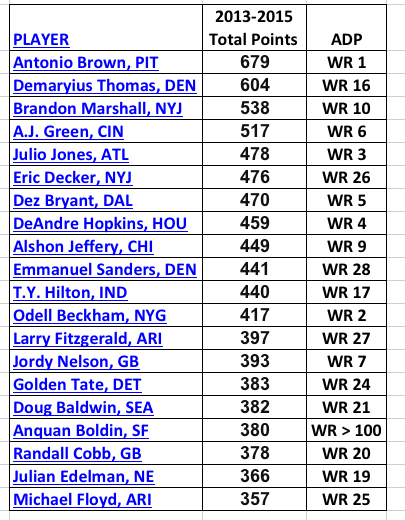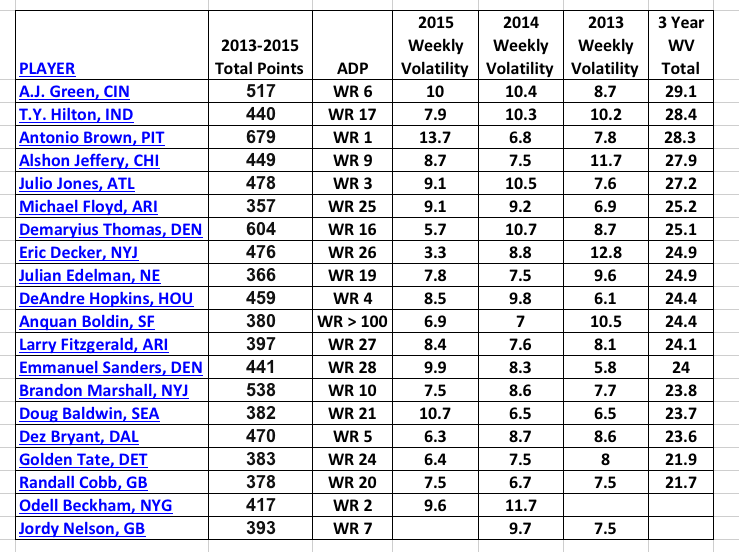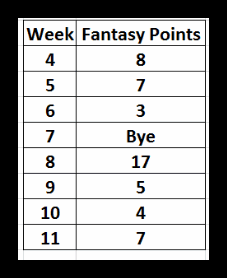A.J. Green is an excellent NFL wide receiver. In just five seasons he has accumulated 415 catches, 6171 yards, and 45 touchdowns. He is the undisputed number one receiving target on a Cincinnati Bengals’ team that is a threat to go to the Super Bowl. Green finished as a top-10 wide receiver in fantasy football last season, and is unanimously perceived as one of the NFL’s most consistent wide receivers. This is a fallacy. In fact, I am not drafting A.J. Green on any of my fantasy teams this season, because he is incredibly inconsistent.
Elite Company
A.J. Green is the fourth overall highest scoring wide receiver over the last three years. However, that only tells half the story. Consistency is the key to winning in fantasy football. Having a player score 22 fantasy points in one week and six the next is significantly worse than that same player scoring 14 points each week. Most of the fantasy leagues are based on biweekly battles, and each week the scoreboard then resets. A.J. Green is being drafted as the 5th to 7th wide receiver off the board on all fantasy platforms. This makes him either an early second round or late first round pick.
Below is a list of the top cumulative fantasy football wide receivers over the last three seasons, as well as their current 2016 ADP:
High Weekly Volatility
One of the best measures for wide receiver fantasy effectiveness is Weekly Volatility. This measures the level of week-to-week fantasy point scoring variance. Players with numbers higher than 8.0 have significant weekly output oscillation, and values over 10.0 indicate an extreme boom/bust range of outcomes. Take a look at that same list with their Weekly Volatility from each season.
A.J. Green is the only wide receiver that has a Weekly Volatility of ten or higher each of the last two seasons. He also has the highest combined rating for the past three seasons (29.1). You simply cannot rely on A.J. Green as a true WR1 on a week to week basis. Wide receivers like Demaryius Thomas (25.1), Julian Edelman (24.9), Jordy Nelson (17.2 over two years) and Brandon Marshall (23.8) all carry significantly less Weekly Volatility from the past three seasons. Yet, each of those players are currently being drafted after Green.

A.J. Green Advanced Metrics Profile
In fact, the only two current wide receivers who had a higher Weekly Volatility than A.J. Green were Doug Baldwin and Antonio Brown. Baldwin’s variance is explained by a run heavy Seattle team that changed offensive philosophy mid season. Brown’s lowest game outputs (4 points, 4 points, 2 points) all occurred when Ben Roethlisberger was injured. A.J. Green’s situation is most concerning because his output variance occurred over multiple seasons and with his starting quarterback healthy.
If we isolate his standard league point production from last season, the results are even clearer. Take a look at his production over an eight week stretch last season:
From Week 4 until Week 11, A.J. Green produced one double digit fantasy week. Just one. Overall, he had nine single digit fantasy weeks out of 16. While Dalton was injured during those games, he showed from the earlier weeks that low single digit performances are not atypical results. In Week 14, which is a typical playoff week, he had a terrible performance scoring just three points on one reception. Your early round selections are players you rely on for the most important fantasy games of the season. In 2015, during a very successful Bengals’ season, A.J. Green was a huge fantasy disappointment for seven of eight weeks, and during a vitally important Week 14 in the fantasy playoffs.
Is that the production you would expect from the first wide receiver you draft this season? Would you be happy with that production? I certainly would not.
The Real Andy Dalton
The other important factor in assessing an early round wide receiver selection is quarterback effectiveness. Andy Dalton played 13 games last season and had some of the best statistics of his career: 28 total touchdowns, only 7 interceptions, and finished 2nd in the NFL in passer rating (106.2). But those are the best numbers of his five seasons by far. The Bengals have finished 15th and 21st the last two seasons in passing yards per game, while ranking 13th and 6th the last two seasons in rushing yards per game. The Bengals prefer to run the ball, and that’s despite running back Jeremy Hill only averaging 3.6 yards per carry last season. The Bengals are at their best offensively when they are running the football.
Andy Dalton is not known for his passing accuracy either. Here are the completion percentages each year of his career: 58.2-percent, 62.3-percent, 61.9-percent, 64.2-percent, and 66.1-percent. These results rank him annually around the middle of starting NFL quarterbacks. In addition, take a look at his red zone statistics over the past three seasons:
Those are mediocre numbers, and not very encouraging if you are spending a first or second round pick on A.J. Green. Andy Dalton is not attempting many red zone passes, and when he does, he only completes them at an average rate. This means for the 2016 season, Green is often going to have to get his touchdowns on long pass plays outside of the red zone. This will be very difficult to do when your quarterback is not known for a strong arm or being highly accurate.
Are we sure that the Andy Dalton we saw in 2015 is the real him? Or could that have just been his career year? If Andy Dalton regresses, this will further hurt A.J. Green‘s value.
Offensive Philosophy
With so many changes on offense, opposing defenses will be completely focused on stopping A.J. Green. The Bengals lost wide receiver Mohamed Sanu (Atlanta), wide receiver Marvin Jones (Detroit), and will start the season without starting tight end Tyler Eifert who is recovering from surgery. Many fantasy analysts think this means that Green will be peppered with targets, but I see defenses scheming to stop him every game. Given the lack of offensive weapons, Green is going to face many of the defensive challenges that Calvin Johnson often faced in Detroit. It should be no surprise that Calvin Johnson is the only wide receiver over the past three years with a higher combined volatility than Green (34.3). It is precisely why I never drafted Calvin Johnson. Ask the person who had Calvin Johnson in 2015 how they felt after he scored just three points at home in a Week One 33-28 shootout with San Diego. Or better yet, ask how they felt after he managed just one fantasy point in a 35-27 loss at New Orleans during Week 15. Teams always schemed to take Johnson out of the offensive game flow, and they will do the exact same thing to A.J. Green this season.
More than likely, the Bengals will return to a run heavy offense, until Brandon LaFell and rookie Tyler Boyd show they can help support the passing offense in a similar way that Mohamed Sanu and Marvin Jones did. I expect a slow start for A.J. Green in 2016, especially until at least Tyler Eifert returns.
Conclusion
When you analyze A.J. Green‘s fantasy value, you should only compare him to his corresponding peer group. Those are the top 12-15 wide receivers that are currently being drafted in rounds one or two. If Green drops to round three, I would draft him in a heartbeat. But if you compare him to those peer group wide receivers, he is not going to be someone I will draft. His Weekly Volatility, unpredictable quarterback play, and overall outlook in the 2016 Bengals’ offense, leave me looking elsewhere for better top round fantasy options in the upcoming season. If you select A.J. Green early in a traditional league, you will enjoy the few 20+ scoring weeks he will have in 2016. However, don’t complain when you suffer through multiple disappointing single digit performances.
A.J. Green is widely perceived to be one of the most consistent wide receivers in the NFL. The volatility metrics say otherwise. Green is highly inconsistent, and is therefore best deployed in best ball leagues that reward volatility.
You have been warned.






